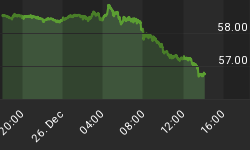Below is an extract from a commentary originally posted at www.speculative-investor.com on 10th April, 2008.
The daily CRB Index chart displayed below reveals an upside blow-off leading to a mid-March peak, followed by a sharp decline and then a rebound. If we are correct to view the March peak as the intermediate-term variety then the current rebound should lead to a secondary (lower) high within the next couple of weeks and then a decline to a new multi-month low.

If the CRB Index completes its topping process over the coming weeks and then takes out its late-March bottom some analysts will undoubtedly claim that the market action is related to deflation (indicating, caused by, or predicting deflation). You should ignore these people. Commodity bull markets invariably experience sharp corrections and when they happen it is not because of, or predictive of, deflation; it is simply due to the market having previously run up too far too fast. Markets routinely overshoot, and after they do it is normal for them to swing back in the opposite direction for a while regardless of the fundamentals.
The CRB's topping process is associated with the US dollar's bottoming process, so as the CRB rebounds to test its March peak the Dollar Index is dropping back to test its March bottom. The following chart shows the Dollar Index's current situation. The pullback by the Dollar Index to test its March low will likely be accompanied by a spike to new highs by the euro, but most of the dollar's competitors should make lower highs.

While on the topic of the inter-relationship between commodities and the US$ it is worth mentioning the Baltic Dry Index (BDI), a measure of ocean-going freight rates. The reason is that there is a loose relationship between freight-rate trends and commodity-price trends, and quite a tight relationship between international freight-rate trends and currency market trends. The second of these relationships has been discussed in several TSI commentaries since last September.
The US$-BDI relationship can be described as follows: Over the past 20 years, important turning points in the BDI have usually coincided with important turning points in the currency market, with peaks in freight rates coinciding with bottoms in the Dollar Index and bottoms in freight rates coinciding with peaks in the Dollar Index.
The following chart of the BDI reveals an intermediate-term topping process (a peak last November followed by an initial sharp decline and then the obligatory rebound) and therefore supports our view that the US$ is bottoming. This, in turn, supports our view that the commodity world is in the early stages of an intermediate-term correction (a multi-month downturn within a bull market).
It is clear that the November-2007 peak in the BDI did not coincide with the ultimate low for the Dollar Index, but it did mark intermediate-term bottoms for the US$ relative to the Canadian Dollar and the British Pound.

If it turns out that we are too bullish about the US dollar's short-term prospects then the biggest beneficiary will most likely be the gold sector. In our opinion, if the Dollar Index makes a SUSTAINED break to a new low then the gold price will quickly move to new highs and the price of the average gold stock, which is currently very depressed relative to the price of gold bullion, will explode upward. But the more likely outcome is that the start of a major advance in the gold sector will wait until May or June -- following the INITIAL phase of a US$ rebound.
















